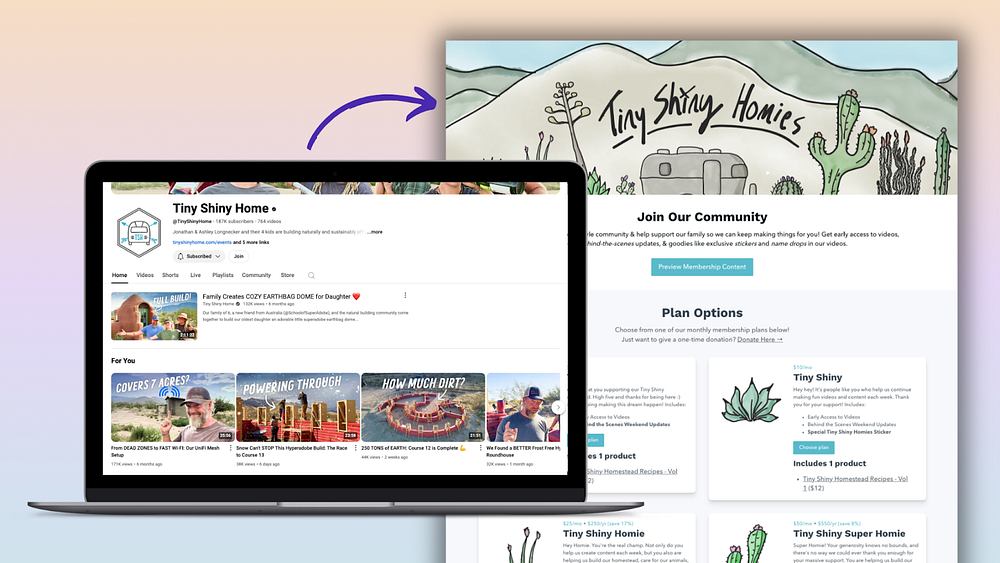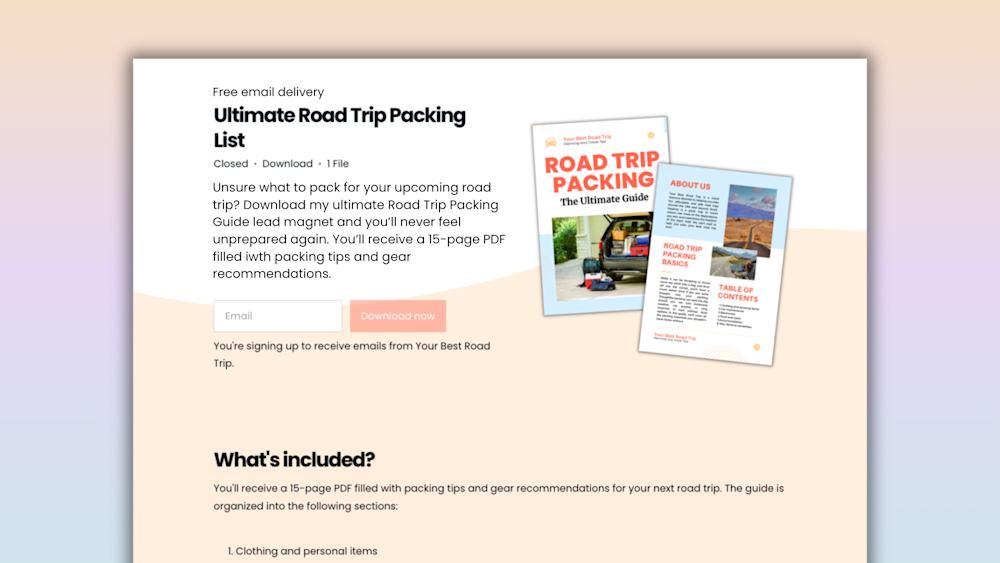You’ve just answered another email from a customer asking for a refund for one of your profitable digital products.
Before rubbing your temples and sighing -- you don’t need to say “au revoir” to your earnings.
Today, we have some news that will rock your world: Refund policies can help you retain more customers and earn more money in the long-run, if you execute them correctly.
If you’re ready to stop the influx of refund emails and create a refund policy that helps your business, join me as we take a look at building a refund policy in three simple steps.
We’ll start off by setting up the terms of your refund policy.
How to write a refund policy for your digital product business
Step #1: Decide the terms of your refund policy
There’s more to offering a refund policy than simply telling your customers you’ll return their money.
You need to first decide which products will be eligible for refund and then determine under which conditions you’ll offer refunds (i.e., if you want to offer a no-questions-asked refund policy or allow customers to receive a refund once certain requirements are met).
For instance, Epic Games’ refund policy states that customers can return a game for any reason, although they must not have played the game for more than two hours.
Likewise, Rosetta Stone’s return and exchange policy lists criteria customers need to meet to receive a refund.
Another detail to determine in your refund policy is timing and how long you’ll offer them.
Take L.L. Bean, which offers a one-year return window for products that are defective.
And Asos, a clothing retailer, that offers refunds within 28 days of the customer receiving their purchase. Customers can receive a voucher if they return an item between 29 and 45 days.
If you’re wondering what ideal window and refund parameters are for your business, check out what others in your industry are doing and test it out accordingly.
So, if you’re a coach, you might follow in the footsteps of other coaches’ 14-day window for refund requests on certain items.
Just like Holly Genser, a career coach, who offers product refunds, but not refunds for custom writing projects already in progress. Holly’s refunds must be requested within 14 days of purchasing one of her products.
Or Dr. Carol Parker Walsh, a career and life coach, who doesn’t offer refunds for coaching and consulting or her digital products, but does offer a 14-day refund window for online training programs.
On top of timing, you can iron out details that you need from customers before issuing a refund, like an explanation of why they want a refund.
By asking customers for the reasons for their product return, you can clearly outline the details in your policy and deter less serious customers from abusing your refund policy.
Crawley Yoga, for instance, enumerates all of the reasons and situations for a refund request and lays out which situations they won’t issue refunds. They also communicate to their customers what happens in the rare case that they do issue a refund.
It’s worth noting, though, there’s a tradeoff here -- when listing a stringent list of refund details, you might deter some skeptical prospective customers, so consider carefully what you publish.
Whether you display a detailed list of refund reasons or not, seeking insights will help you better understand why customers, who were genuinely interested in your product, become dissatisfied. This information is gold for discovering ways to make future customers happier.
Besides, there are so many reasons why your customers may become dissatisfied with your product. It’s vital to pinpoint the biggest reason so you can improve your product in the right way.
For instance, 29% of shoppers say they return a product because it was misrepresented. Another 59% claim they returned something because it was defective.
So, if you see a high number of refunds, you may need to tweak your marketing messages to better align with what your product delivers. Or it could mean you need to iterate your product.
Customer research is the only surefire way to find out the truth on how to fix your customer refund request problem.
Also, just because you’re issuing refunds doesn’t mean you have to lose revenue.
The returns process is an opportune time to recommend a product that may be a better fit for your customers’ needs.
After all, a whopping 62% of global shoppers have purchased something to replace what they returned.
This means, chances are, your customers still need something to replace their return item. Another one of your products may just be what they’re looking for.
Let’s say a student wants a refund on a course about learning conversational German because it was too advanced for them.
Instead of refunding their money, you can recommend she enroll in your advanced beginner conversational German course or purchase private lessons instead, assuming they’re around the same price tag.
As for writing a policy of your own, you can use these templates from Termly and this return and refund policy generator to get started.
Of course, don’t just copy and paste a refund policy from a template, but rather, customize the terms and conditions to address situations unique to your industry or business.
If you use payment plans for your products, decide if you’ll refund the entire amount customers have paid or only the most recent payment.
If you only accept one-time payments, determine if you’ll refund the entire product price or prorate the refund for the content your customer hasn’t yet accessed.
You’ll also want to customize your refund policy to be strict (within reason) and specific to your brand, to keep customers from abusing your policy.
This is something retailers are catching on to, with 20% of retailers making their return policies more strict between 2018 and 2019.
What’s more, 31% of those businesses say they firmed up their refund policies because customers were using their products and then returning them.
In summary:
Determine the conditions of your refund policy, including a list of eligible products, the timing, and specific terms. Then, customize templates to address policies and situations relevant to your company.
As for how to customize them, look to our next section.
Step #2: Be clear about your refund policy’s terms
The second step in creating a refund policy that doesn’t kill your bottom line is to clarify everything in easily digestible terms.
Your customers probably don’t want to rummage through a complex refund policy.
So, it’s wise to write your refund policy in clear, simple language. (For additional resources on writing in plain language, you can check out these useful guidelines.)
On top of writing in explicit language, design the layout of your page with plenty of white space. You can also highlight key points in headers or lists, using bold or italics, which makes it easy for customers to find what they need on your refund page.
After all, a mighty 79% of online readers scan online pages, and only 16% will read a page word-for-word.
Plus, website readers read a few sentences or parts of sentences to get the gist of a section and prefer short, concise pages.
To increase readability and shrink the number of customers that reach out to you to explain your refund policy, format your content to match people’s reading styles.
Research has found that people tend to read online pages in an F-shape, as in the images below.
There’s also more recent data that tells us people read in a lawn-mower pattern, like this:
Formatting your refund policy to match the F-shape or lawn-mower pattern can help customers find information more easily and also provides your customers with an overall more enjoyable user experience.
Now, for some examples of well-written, concise refund policies.
Scribd, an audiobook and ebook service, has a short, to-the-point refund policy.
Social Media Examiner’s refund policy features simple sentences and clear explanations of when customers can receive a refund.
Stephanie Nickolich’s refund policy features a healthy helping of white space, bold headers, and short, clear sentences.
For an F-shape example, look to Mulco Watches, which formatted their return and exchange page for easy reading.
Basically, simplicity is the name of the game when it comes to writing your return policy. Be explicit in both your language and refund page layout.
Then, after you click “publish”, put our final step into place and share your refund policy with your customers.
Step #3: Communicate your refund policy to your customers
Your final step in creating your refund policy is to make it easily accessible to your customers.
You can start by placing it prominently on your website.
For example, Warby Parker has a dedicated help page where customers can easily find their return and exchange policy, among other common questions.
Alternatively, you can include a truncated version of your return and exchange policy at the bottom of your homepage, as Bonobos does.
Another option is to include your refund policy in an FAQ section like Mackenzie Child does, who features his refund policy in a FAQ section on his online course sales page.
Besides your website, it’s worth periodically sharing your return policy on social media, too.
While sharing a tweet or Facebook post that outlines your refund policy may sound strange, hear me out.
The more people know about your refund policy, the better. In fact, if your customers don’t have a clear understanding about your policy, it can work against your bottom line.
So much so that 52% of people abandon their online carts because they worry about a difficult return process.
Conversely, an overwhelming 96% of consumers say they’d shop with a retailer again if they had an “easy” or “very easy” return experience with them.
Plus, 53% of consumers claim they’re more likely to purchase from businesses that are transparent on social media.
So, letting people know about your refund policy can overcome a lot more objections than you think.
If sharing your refund policy on social media isn’t for you, we also recommend sending customers marketing emails containing your refund policy.
For instance, Teva uses the email below to promote their free shipping and easy returns as a selling point.
MarketingProfs is another great example, highlighting a risk-free cancellation policy in an email that promotes an upcoming B2B Forum event.
Basically, to encourage more sales, make it easy for shoppers to find and understand your refund policy. You have options when it comes to sharing your product refund policy, from your website to social media and emails.
Whichever medium(s) you choose, the key point is to make sure your customers are aware of your policy, so they won’t be in for any unpleasant surprises after making a purchase.
Use these 3 steps to write a refund policy that saves your profits
The good news: You no longer have to hold your breath and prepare for the worst when you see a refund request.
Even better news: You can create a refund policy that saves you from answering an endless stream of refund requests -- and blows to your revenue -- in three easy steps.
In order, those steps are to:
-
#1. Determine which of your products will be eligible for a return. Then decide in what situations and for how long of a period those products can be refunded.
-
#2. Write your refund policy using clear, everyday language so your customers will understand how to return a product and receive a refund.
-
#3. Make your refund policy easy to find. Minimally, you should share your policy on your website, but you can also share it on your social media channels and email newsletter as part of your marketing campaigns.
We’re standing behind you as you craft a refund policy that helps both your business and your customers.
P.S. If you’re still missing an all-in-one tool for managing your homepage, we’ve also got your back. Just use this 30-day no obligation trial to give it a test drive.



